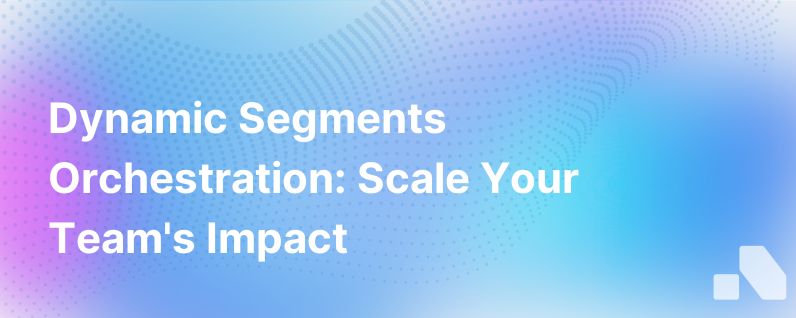
In the fast-paced, competitive arena of modern business, teams are constantly on the lookout for strategies that can help them punch above their weight. As a result, the interest in methodologies and tools that can streamline operations and amplify impact is not just a fleeting trend, it's essential for survival and growth. Dynamic segmentation and orchestration stand at the forefront of this shift, poised to make a significant difference in how teams operate. Let's delve into the concepts of dynamic segments and orchestration, and explore how adopting these strategies can effectively double the size of your teams.
Embracing Dynamic Segmentation
Dynamic segmentation is the practice of partitioning your customer base into ever-changing groups based on real-time data. Unlike static segmentation, which categorizes customers based on historical data and fixed attributes, dynamic segmentation adapts to new information, customer behavior, and market trends. This adaptability ensures that your outreach initiatives are timely, relevant, and personalized.
The Power of Real-Time Data
The core of dynamic segmentation lies in real-time data utilization. As behaviors, preferences, and needs ebb and flow, so do the segments to which individuals belong. For example, a customer who was once grouped under a 'low engagement' segment could swiftly shift to 'high potential' based on their interaction with a recent product update.
Customization at Scale
Dynamic segmentation allows businesses to automate and customize marketing and sales efforts at an unprecedented scale. With customers neatly organized into fluid segments, teams can curate highly personalized campaigns that address the nuanced needs of each segment, resulting in significantly higher engagement and conversion rates.
Predictive Capabilities
By harnessing machine learning algorithms, dynamic segmentation also has a predictive element, identifying trends and potential future behaviors. This insight enables teams to preemptively tailor their approach, aligning with customer journeys before they unfold.
The Symphony of Orchestration
While dynamic segmentation provides the foundational knowledge needed to understand customer groups, orchestration is the deployment strategy that animates this information into action. Orchestration in business refers to the coordinated effort to engage customers across multiple channels seamlessly and cohesively, relying heavily on automation and predefined workflows.
Multi-Channel Strategy
Effective orchestration capitalizes on various channels — from email, social media, and SMS to push notifications and beyond — to engage with individuals where they are most responsive. It aligns messaging across these platforms to create a consistent, impactful narrative.
Workflow Automation
Automation is the engine that powers orchestration. By automating repetitive tasks, workflows are streamlined, and the probability of human error is reduced. It also frees up precious time for team members to concentrate on high-value activities, such as strategy and relationship building, effectively amplifying the resources at their disposal.
Data-driven Decisions
Orchestration thrives on data-driven decision-making. With detailed insights into customer behaviors and the performance of past campaigns, teams can make informed choices about when, where, and how to engage each segment, ensuring optimal outcomes from their actions.
Doubling Team Efficiency and Effectiveness
The combination of dynamic segments with orchestration has a multiplicative effect on team productivity.
Amplified Personalization
With dynamic segments constantly feeding fresh data into orchestrated campaigns, personalization goes beyond the 'first-name basis' level. It means delivering the right message, to the right person, at the right time — an equation that fosters higher trust and loyalty from customers.
Proactive Engagement
Through predictive analysis, teams can anticipate customer needs and initiate engagement proactively, often before the customer even recognizes the need themselves. This proactive stance positions companies as thoughtful and anticipatory, standing out in crowded markets.
Streamlined Operations
Allocating resources wisely is critical for lean teams aiming to accomplish more with less. By automating the orchestration of tasks and segment updates, employees are liberated to handle activities that demand a human touch, such as strategic planning or creative campaigns, thus doubling or even tripling their productivity.
Heightened Adaptability
Business agility is another benefit reaped from dynamic segmentation and orchestration. The ability to adapt campaigns and engagement strategies in real-time makes a business more resilient to market changes and capable of seizing fleeting opportunities.
Implementation
How do businesses implement dynamic segmentation and orchestration? Advanced platforms, such as customer relationship management (CRM) systems integrated with marketing automation tools, are at the heart of this strategy. Analytics and AI play vital roles in both identifying valuable customer segments and in orchestrating cross-channel, data-informed customer experiences.
A Case for Tools like Aomni
This is where platforms like Aomni become instrumental. They empower businesses to not only identify dynamic segments with precision but also facilitate orchestration across numerous touchpoints. With the capabilities to glean real-time account research, leverage competitive insights, and generate personalized sales content quickly and effortlessly, these AI-driven platforms are the embodiment of efficiency.
Deploying Aomni can revolutionize how B2B sales teams operate, functioning as a force multiplier that gives the impression of a more sizable, capable outfit. Through intelligent, automated solutions, Aomni enhances both segmentation and orchestration, empowering your teams to punch well above their weight class and make every interaction count.
Conclusion
In sum, embracing dynamic segmentation and orchestration transforms the efficacy of business operations, enabling teams to operate with the precision and adaptability required to thrive in the current business climate. It's a strategy that not only makes the teams feel twice the size but also drives measurable results in customer engagement, satisfaction, and revenue. It’s not about working harder, but smarter — and that’s the philosophy that is changing the game for forward-thinking businesses around the globe.